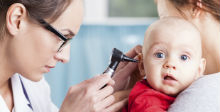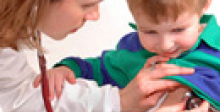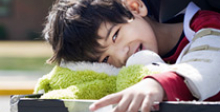Although Cerebral Palsy does not cause respiratory distress, associative conditions can lead to life-threatening respiratory issues, such as pneumonia, aspiration and choking. A child’s respiratory health must be diligently monitored to treat symptoms and conditions before they become unmanageable. Proper management of respiratory health can improve the quality of life.
Respiratory therapy and Cerebral Palsy
Respiratory functioning is one of the human body’s most vital roles. It allows us to breathe properly and consume food and liquids and it serves as a pathway for the body’s organs to perform their most basic functions. Without a steady stream of oxygen, these organs can shut down.
It is estimated that 86% children with Cerebral Palsy have oral-motor dysfunction, which is an inability to control the facial and neck muscles. This can lead to difficulty in swallowing, breathing or communicating; it can also make a child more prone to choking, aspiration, and pneumonia.
Young people with Cerebral Palsy, depending on the type and severity of their condition, are especially vulnerable to respiratory dysfunction; complications that can begin as a respiratory issue are often life-threatening. Respiratory function requires a person to breathe properly, cough effectively and treat respiratory infections promptly.
Often, respiratory issues are easy to detect because a child shows outward signs of discomfort. Other times, respiratory issues are nearly impossible to detect or can be considered a bad cold. A delay in diagnosis, inability to disclose discomfort, or unsuitable assessment can complicate prognosis. This means parents must be proactive in terms of guarding against respiratory health issues that under the best of circumstances can cause discomfort, but under the worst of conditions can lead to life-threatening situations.
What is respiratory therapy?
Respiratory therapy is the care and treatment of all pulmonary and cardiology conditions. The formal practice of respiratory therapy began more than six decades ago, when respiratory therapy was called “oxygen management.” At this time, respiratory therapy was focused on airway management caused by disease of trauma, but not looked at as an ongoing medical intervention.
Today, respiratory management is a key component in a child’s treatment plan because of the potential for respiratory dysfunction to trigger complex, life-threatening issues. A child will likely not be seen regularly by a respiratory therapist – as they would regularly be seen by a physical or occupational therapist. But depending on a child’s condition, particularly if a child uses a feeding tube as a primary source of nutrition, a child may need to have his or her respiratory conditions closely monitored.
Although respiratory issues may not be immediately noticeable, there are some strong indicators that respiratory problems are afoot, including:
- Breathing
- Breathlessness
- Chest rattle
- Heavy breathing without exertion
- Postural drainage
- Retained secretions that physically obstruct airways
- Wheezing
- Feeding
- Acid reflux disease, or GERD
- Aspiration
- Chewing difficulties
- Gagging
- Swallowing difficulties
- Facial Functioning
- Drooling
- Problems sucking
- Health Issues
- Bacterial colonization from stagnate secretions
- Bronchospasm
- Infectious exacerbations
- Low or reduced activity levels
- Persistent coughs
- Recurrent chest infections
- Recent case of pneumonia
- Unexplained fatigue
- Communicating
- Non-verbal
- Speech-language issues
The presence of any of these complications, especially more than one and for a prolonged period of time, can make the child more prone to life-threatening associative conditions, including:
- Asthma
- Bowel obstruction
- Bronchitis
- Bronchiolitis
- Bronchopulmonary dysplasia
- Choking
- Chronic lung disease
- Chronic pulmonary aspiration
- Failure to thrive
- Gastroesophageal reflux, or GERD
- Heart trouble
- Lung infection
- Malnutrition and undernourishment
- Pneumonia
- Respiratory failure
- Respiratory distress syndrome, or RDS
- Vitamin deficiency
- Weakened immune system
Proper care and management of respiratory conditions, however, can greatly diminish the chances that a child will succumb to these conditions.
What are the benefits of respiratory therapy?
Simply put, the benefit of diligently monitoring a child’s respiratory health is the opportunity to protect his or her lifespan and improve his or her overall health and comfort.
If a child experiences respiratory issues, he or she will not be able to function in a conventional way. Respiratory therapy can bring to bear a number of treatments that will greatly enhance a child’s health and comfort. It gives a child, and his or her parents, options in terms of short-term and long-term interventions and supports that can short-circuit respiratory problems before they occur. Those interventions include:
- Nutritional assessments
- Feeding strategies
- Oxygen treatment
- Positioning>
- Prophylactic antibiotics (those that encourage airway function)
- Nebulizers
- Inhalers
- Intubation
Secondary conditions can also be diagnosed and treated during therapy. Those conditions include:
- Sleep apnea
- Gastrointestinal conditions
- Asthma
- Breathing conditions
- Cough or cold
Why are children with Cerebral Palsy predisposed to respiratory dysfunction?
Children with Cerebral Palsy have a number of physical issues to cope with, but respiratory dysfunction was one of the most insidious.
Because Cerebral Palsy is the result of brain damage that can lead to the inability to control muscles, including facial and neck muscles, a number of issues can present when the body’s ability to swallow, chew, suck, breathe and feed are compromised. To function properly, the body requires the ability to pass air or substance through the mouth, to the pharynx and into the esophagus. When breathing, the passage way has to be clear to air, but while eating or drinking, the air passage way has to close. It requires complex neuromuscular activity to function correctly.
For example, in the oral phase, the mouth contains the food, saliva moistens it, chewing breaks down the food, the tongue positions the food to be swallowed, and then the food is propelled into the pharynx. In the pharyngeal phase, airways are closed while food is passed through, then reopened to allow breathing. If food or air is caught, choking or aspiration can occur. In the esophageal phase, the food is swallowed, and the esophageal passageway is relaxed and recoiled while a lower esophageal sphincter helps to keep the food down.
If these muscles are impaired, the body’s ability to function properly in these capacities can lead to a myriad of secondary conditions and the potential for life-threatening associative conditions.
A child may experience problems swallowing liquids or food because the complex muscles of the mouth and throat are not working properly. This can lead to choking, breathing problems and aspiration.
Aspiration is considered to be the most common respiratory complication that children with Cerebral Palsy face. Aspiration occurs when a person’s difficulty swallowing food or liquids leads to the inhalation of particles and inflammation of the airway.
Also, a child may be unable to cough up secretions that physically obstruct their airways. Stagnate secretions can lead to infections and bacterial colonization. Either of these circumstances can cause lung infections or pneumonia, and over time, can lead to a lethal cycle of recurrent infections and progressive pulmonary deterioration. Respiratory management, in this circumstance, focuses on breaking the cycle of recurrent infections with aggressive attention to airway clearance.
If a child has a more severe case of Cerebral Palsy, the musculature of the airway may also be deformed because of extra tone, a chest wall deformity, or a curved spine. Deformities can restrict breathing and proper lung expansion, and interfere with oxygen and nutrient consumption. This can lead to frequent respiratory dysfunctions that can result in serious complications later in life.
Also, a child that is malnourished because of inadequate food intake, oral dysphagia, or acid reflux will often suffer from reduced lung function, which makes the child vulnerable to infections.
Although a parent may feel he or she can detect a respiratory issue, they can go undetected. If a child is non-communicative, this can be especially dangerous because he or she may not be able to inform a parent or physician that a respiratory issue exists.
If a parent notices any of the tell-tale signs in a child, or if he or she has a suspicion that a child is suffering from less-apparent symptoms, it is advised that the child consult with a respiratory therapist.
When is therapy advised?
Because every case of Cerebral Palsy is different, his or her condition is unique. This means that any number of issues can come into play when a child’s treatment is being mapped out, including whether a child has secondary and associative conditions that affect his or her respiratory health.
When a child has a mild form of Cerebral Palsy, his or her condition may not require strict respiratory monitoring. Other children, however, will need to have their respiratory health monitored more closely.
A child’s respiratory condition may be monitored after he or she is born; this is especially true if a child is born pre-term or if asphyxia occurred before, during or after birth. Because premature babies are known to have underdeveloped lung capacity, doctors are usually prepared to monitor lung activity and oxygen levels.
Although Cerebral Palsy is not a progressive condition, secondary and associative conditions can occur, sometimes abruptly. The bottom line is that if a parent detects any respiratory issue, he or she must take a child to see his or her therapist or physician. And, if a child has a history of respiratory issues, his or her ongoing condition must be diligently monitored.
How is respiratory therapy performed?
An appointment with a respiratory therapist begins like other medical appointments, with an evaluation that includes several tests as well as a full assessment of a child’s symptoms and medical history. The therapist will take note of any prior condition that is indicative of reduced lung capacity, oxygen deprivation, and low oxygen levels.
The therapist will conduct a full exam of a patient’s breathing capacity by asking him or her to breathe into an instrument that measures how deeply a child inhales and exhales. Typically, the patient will undergo the test sitting upright to ensure that his or her chest is not restricted. The therapist will examine the upper lung fields for irregularities. It is during this phase that a physician will look for:
- The position of the child and how it affects their ability to breathe
- The palpitation, or vibrations, of a child’s anterior and posterior chest wall
- The percussion of a child’s anterior and posterior chest wall, which measures inequities in lung field density
- The auscultation – or wheezing, cracking and noises – in a child’s lung fields
A child will also need to have blood drawn to determine:
- Oxygen levels
- pH levels
- Carbon dioxide levels
The therapist will measure a child’s respiratory rate while they are relaxed. The therapist will make a note of decreased respiratory rates, abnormal movements of the diaphragm, increased jugular pulse (right heart failure) and any changes in a child’s breathing.
The therapist will also examine any physical issues that may be exacerbating a child’s respiratory condition including:
- Scoliosis (lateral curvature of the spine)
- Kyphosis (anterior-posterior curvature of the spine)
- Pectus excavatum (concave sternum)
- Pectus carinatum (protruding sternum)
- Barrel chest
Treatment protocol varies depending on the diagnosis, but may include:
- Cough assist – a somewhat forceful attempt to immobilize secretion and mucus build-up. Techniques vary from tickling to suction catheterization.
- Cough stimulation
- Exercise – breathing exercises designed to expand lung capacity, level respiration regularity, and strengthen chest mobility and respiratory functioning.
- High frequency chest wall oscillations – a vest that rapidly inflates and deflates via an air pressure generator, compressing the chest wall at a specified frequency and pressure to dislodge mucus from the bronchial walls.
- Hydrotherapy
- Percussion and chest wall vibrations – that remove secretions faster than positioning alone.
- Positioning – position child in ways to address breathlessness, improve ventilation, and for postural drainage
- Suctioning – the forceful extraction of mucus plugs and stagnant secretions in an effort to reduce the incidence of infection, bacteria build-up and pneumonia.
What if my child needs a feeding tube?
A child that is having respiratory issues may undergo a swallowing study that can help determine whether or not it is safer, and more prudent, to surgically install a feeding tube to provide vital nutrients to a child.
Tube feeding can improve a child’s ability to suck, swallow, chew, and digest food. Surgeries that use feeding tubes are considered gastroenterological in nature. These interventions include:
- Nasogastric tube – a nasogastric tube can be placed through the nose to introduce food to the stomach. This is usually considered a short-term option as the tube may interfere with swallowing and vomiting reflexes in the long-term.
- Gastrostomy tube – this tube is inserted through the abdominal wall to the stomach allowing for uninterrupted oral feeding while supplementing nutrients.
- Fundoplication – a surgical procedure that places a valve at the top of the stomach to reduce recurrent vomiting, chest infections and acid reflux disease. This procedure can assist with minimizing reactive airway disease, asthma, choking attacks, anemia or wheezing.
- Submandibular duct relocation – this surgical procedure addresses drooling once other measures such as adaptive devices, medications, and therapy are exhausted and proven ineffective.
- Bladder augmentation (augmentation cystoplasty – AC) – a type of bladder surgery provides urinary continence for those that lack bladder capacity or have abnormal compliance that results in urinary tract infections, urgency, frequency, incontinence and other bladder function difficulties.
Where does respiratory therapy occur?
Typically, respiratory therapy will take place in an outpatient setting at a physician’s office. However, there are other places and circumstances where a child may undergo therapy. These include:
- Acute care centers
- Long-term care facilities and nursing homes
- Rehabilitation centers
- Hospitals
- Asthma treatment centers
- Clinics
- Home
Who provides physical therapy?
Respiratory therapists provide therapy to a wide range of individuals from children to the elderly. They are medical professionals that provide direct care in a variety of environments, and work as part of a medical team under the supervision of a physician.
In the United States and Canada, respiratory therapy is recognized individually as a profession, and persons wishing to become practitioners must pursue a specific educational and career track. This is also the case in a handful of European countries, although many still don’t recognize the field. In some places, a respiratory therapist may be called a pulmonary technician.
Respiratory therapy remains one of the few medical professions that a person can pursue with an associate’s degree, although employers are increasingly looking for candidates that have achieved a bachelor’s degree in respiratory therapy. However, there are far more two-year educational programs than four-year programs operating in the United States today.
Therapists take a variety of coursework, including:
- Anatomy
- Physiology
- Biology
- Chemistry
Respiratory therapists must pursue certification to practice in the vast majority of states. Credentials are offered through the National Board for Respiratory Care, or by individual state medical boards. Therapists must sit for an examination at a NBRC or their state’s medical licensing board to qualify for employment.
First therapists are credentialed as a CRT, or certified respiratory therapist. After a person has achieved this status, they are eligible to pursue RRT, or registered respiratory therapist, certification.
People pursuing careers in respiratory therapy can pursue sub-specialties within their field, such as assisting anesthesiologists, cardiovascular perfusion, pediatrics, or asthma therapy, but in doing so, they must pursue additional education and certification. To meet this need, the NBRC has created seven distinct certifications that therapists may pursue.
Is there any risk or special consideration for physical therapy?
The process by which a respiratory therapist assesses, then treats, a child is considered to be very safe and carries with it few, if any, risks. Risks vary depending upon the method of treatment given. A bigger risk would be not aggressively monitoring a child’s respiratory condition to diligently treat and monitor respiratory health.

Therapy for Cerebral Palsy
A person’s ability to transcend his or her physical limits is in no small part due to the kinds of therapies that are used to fine-tune his or her abilities. Therapy fosters functionality, mobility, fitness, and independence. The types of therapies vary based on a person’s unique needs, type of Cerebral Palsy, extent of impairment and associative conditions. Therapy can also help parents and caregivers.
Therapy for Cerebral Palsy includes
- Acupuncture
- Aqua Therapy
- Behavioral Therapy
- Chiropractic Intervention
- Conductive Education
- Hippotherapy
- Intensive Suit Therapy
- Massage Therapy
- Music Therapy
- Nutrition and Diet Plan Counseling
- Occupational Therapy
- Physical Therapy and Physiotherapy
- Play Therapy
- Recreation Therapy
- Respiratory Therapy
- Sensory Integration Therapy
- Social Therapy
- Speech and Language Therapy
- Vocational Counseling








